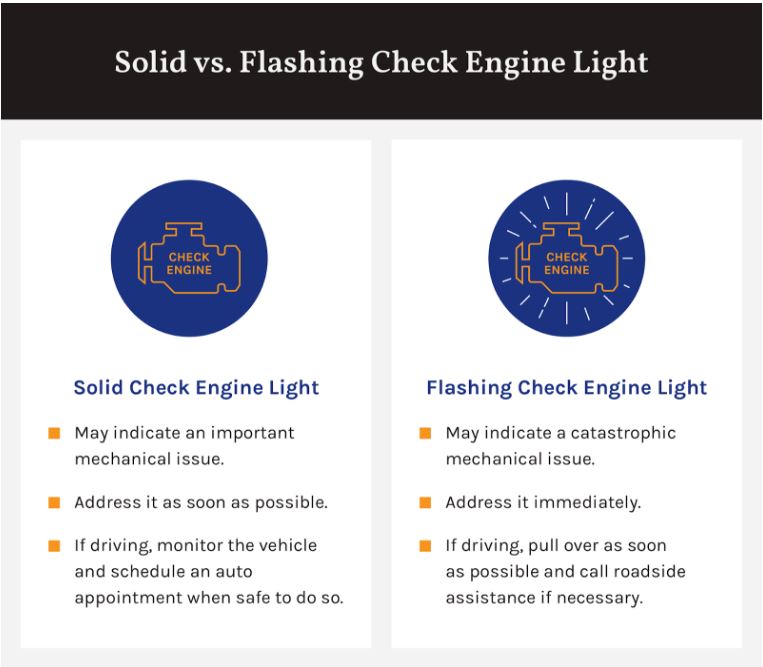Seeing your check engine light on can be worrying. It signals a possible issue with your car.
Your check engine light plays a crucial role in your vehicle’s health. When it turns on, it means the system has detected a problem. This light could indicate something minor or something more serious. Ignoring it can lead to bigger issues and costly repairs.
It’s essential to understand what could trigger this warning. In this post, we’ll explore common reasons for this light to appear. Knowing these can help you take quick action. You’ll save time, money, and keep your car running smoothly. Let’s dive into the possible causes behind that alert.

Credit: www.broadviewinsuranceagency.com
Loose Gas Cap
One common reason your check engine light may turn on is a loose gas cap. This small issue can cause your vehicle to signal a problem. Understanding the connection can save you time and stress.
How A Loose Gas Cap Triggers The Light
The gas cap seals the fuel system. It prevents fuel vapors from escaping. A loose or missing cap disrupts this seal. This can trigger the check engine light. Your car’s computer senses a drop in pressure. It then alerts you with the light. This is a simple issue, yet it can affect your car’s performance.
Simple Fixes
First, check the gas cap. Ensure it is properly tightened. Turn it until you hear a click. If the cap is damaged, replace it. New gas caps are inexpensive. You can find them at any auto parts store. After fixing the cap, the light may go off. If it stays on, drive for a while. The computer may need time to reset.
Oxygen Sensor Issues
Oxygen sensor issues can be a common cause of your check engine light. This small but crucial component helps your car’s computer ensure optimal engine performance. When it fails, it can lead to a variety of problems.
Role Of The Oxygen Sensor
The oxygen sensor monitors the amount of oxygen in your car’s exhaust. It sends data to the engine’s computer to adjust the air-fuel mixture. This ensures your engine runs efficiently and reduces emissions. If the sensor isn’t working, the computer can’t make these adjustments correctly.
Symptoms And Solutions
<pone a="" another="" car="" economy.="" engine="" faulty="" fuel="" gas="" idle.
Replacing the oxygen sensor is often necessary. This can solve many of the issues caused by a faulty sensor. A mechanic can diagnose the problem and replace the sensor if needed.
“`
Faulty Catalytic Converter
A faulty catalytic converter can trigger your check engine light. This crucial component reduces harmful emissions. It helps your car meet environmental standards. When it fails, your vehicle may not run efficiently.
Signs Of A Faulty Converter
There are several signs of a faulty catalytic converter. One common sign is reduced engine performance. You may notice a drop in power. Your car may struggle to accelerate. Another sign is poor fuel economy. Your vehicle may consume more fuel than usual. You might also hear rattling noises from under the car. This happens when the converter breaks apart.
A strong smell of sulfur or rotten eggs is another indicator. This smell comes from unburned fuel. It passes through the exhaust system. Finally, your car may fail an emissions test. This is a clear sign of a malfunctioning converter.
Replacement Options
If your catalytic converter is faulty, you have options. You can choose between original equipment manufacturer (OEM) parts and aftermarket parts. OEM parts are made by the car’s manufacturer. They ensure perfect fit and function. They can be expensive.
Aftermarket parts are made by other companies. They can be less expensive. Some may not meet the same standards as OEM parts. It’s important to research and choose a reputable brand. Another option is to consult with a trusted mechanic. They can help you decide the best course of action.

Credit: topdriver.com
Malfunctioning Mass Airflow Sensor
Have you ever noticed your check engine light turning on and wondered what could be wrong? One common cause is a malfunctioning Mass Airflow (MAF) sensor. This sensor plays a crucial role in your car’s engine performance by measuring the amount of air entering the engine. When it fails, it can lead to several issues that can affect your vehicle’s performance.
Symptoms Of A Bad Maf Sensor
A bad MAF sensor can cause your car to exhibit several symptoms. One common sign is poor fuel economy. You might notice that you’re filling up your gas tank more frequently than usual.
Another symptom is a rough idle. If your car shakes or vibrates excessively when it’s idling, your MAF sensor could be the culprit.
Additionally, a faulty MAF sensor can lead to acceleration problems. Your car might hesitate or jerk when you press the gas pedal.
Steps To Repair
Repairing a MAF sensor can be straightforward. First, you need to locate the sensor. It’s typically found between the air filter and the engine’s intake manifold.
Once you’ve found it, carefully disconnect the electrical connector. Then, remove the sensor from its housing.
Clean the sensor using a special MAF sensor cleaner. Make sure to follow the instructions on the cleaner’s label. Avoid touching the sensor’s delicate parts with your fingers.
After cleaning, let the sensor dry completely. Reinstall it and reconnect the electrical connector. Start your car to see if the check engine light is off. If the light remains on, you might need to replace the sensor.
Have you ever dealt with a malfunctioning MAF sensor? What was your experience? Share your thoughts in the comments below!
Spark Plug And Ignition Coil Problems
The check engine light can be a worrying sight for any driver. One common cause is problems with the spark plugs and ignition coils. These components play a crucial role in the engine’s performance. If they malfunction, your vehicle’s engine may not run smoothly.
Common Spark Plug Issues
Spark plugs ignite the air-fuel mixture in the engine. Worn or damaged spark plugs can cause misfires. Misfires lead to a rough engine idle and reduced fuel efficiency. Over time, spark plugs can get covered in carbon deposits. This affects their ability to create a strong spark.
Replacing spark plugs at recommended intervals can prevent these issues. Always check your vehicle’s manual for specific maintenance schedules. Using the correct type of spark plug is also crucial. Incorrect spark plugs can cause engine problems.
How Ignition Coils Affect Performance
Ignition coils transform the battery’s voltage to a higher voltage. This high voltage is needed to create a spark in the spark plugs. Faulty ignition coils can result in weak sparks or no spark at all. This leads to poor engine performance and increased emissions.
Signs of ignition coil problems include engine misfires and a decrease in power. If the check engine light comes on, it’s wise to check the ignition coils. Regular maintenance and inspections help in catching these issues early. Replacing faulty ignition coils can restore engine performance.
Defective Thermostat
One common reason for the check engine light to turn on is a defective thermostat. The thermostat plays a crucial role in regulating your engine’s temperature. If it fails, it can cause your engine to overheat or run too cold. This can trigger the check engine light and lead to further issues.
Indicators Of A Bad Thermostat
A bad thermostat can cause several noticeable symptoms. One indicator is fluctuating temperature readings on your dashboard. You might also experience poor engine performance or reduced fuel efficiency. If your heater stops working, this could also signal a thermostat problem.
In some cases, you might notice coolant leaks. This happens because a faulty thermostat can lead to uneven coolant flow. Another sign is if your engine overheats quickly after starting. These symptoms suggest that your thermostat might be defective.
Repair And Replacement
Repairing or replacing a thermostat is a task best left to professionals. Mechanics can diagnose the issue accurately and ensure the right fix. They will typically remove the faulty thermostat and replace it with a new one.
It is important to act promptly. Delaying repair can cause more damage to your engine. Regular maintenance can help prevent thermostat issues. Make sure to follow your vehicle’s service schedule.
Vacuum Leak
A vacuum leak might cause your check engine light to turn on. It disrupts the engine’s air-fuel mixture, leading to performance issues. Identifying and fixing the leak can resolve the problem.
If you’ve ever seen your check engine light come on, you know the sinking feeling it brings. One common culprit is a vacuum leak. This often-overlooked issue can trigger your check engine light and cause a range of problems. Let’s dive into how to recognize and fix a vacuum leak.
Signs Of A Vacuum Leak
Identifying a vacuum leak can save you time and money. Common signs include a rough idle, stalling, or even a hissing sound from under the hood.
Your car might also experience a drop in fuel efficiency. If you notice these symptoms, a vacuum leak could be the reason.
Experiencing any of these issues can be frustrating, especially when you’re in a hurry. But knowing the signs can help you address the problem quickly.
Finding And Fixing Leaks
Locating a vacuum leak can be tricky. Start by listening for a hissing sound near the engine. This sound often points to the location of the leak.
You can also use a smoke machine to detect leaks. The smoke will escape from the leak, making it easier to find.
Once you’ve found the leak, fixing it is usually straightforward. Replace any cracked or damaged hoses. Tighten loose connections.
Regular maintenance and inspections can prevent vacuum leaks. Keep an eye on your hoses and connections to avoid future issues.
Have you ever experienced a vacuum leak? How did you handle it? Share your tips in the comments!

Credit: www.autotechiq.com
Exhaust Gas Recirculation Valve Failure
The check engine light can be a cause of concern for many car owners. One potential reason for this light is the failure of the Exhaust Gas Recirculation (EGR) valve. This component plays a crucial role in reducing emissions and maintaining engine efficiency. Understanding the EGR valve’s function and recognizing the symptoms of its failure can help you address the issue promptly.
Role Of The Egr Valve
The EGR valve helps reduce nitrogen oxide emissions. It does this by recirculating a portion of the exhaust gases back into the engine’s intake manifold. This process lowers the combustion temperature, leading to fewer harmful emissions. The EGR valve ensures your car runs cleaner and more efficiently.
Symptoms And Fixes
One common symptom of EGR valve failure is a rough idle. Your engine may feel shaky or unsteady. You might also notice a decrease in fuel efficiency. The car consumes more fuel than usual. A malfunctioning EGR valve can also cause engine knocking. This is often accompanied by a distinct noise from the engine.
Fixing a faulty EGR valve usually involves cleaning or replacing the valve. Cleaning the EGR valve can remove carbon buildup that restricts its function. If cleaning does not resolve the issue, you may need to replace the valve. Always consult a professional mechanic for accurate diagnosis and repair.
Worn Out Spark Plug Wires
Worn out spark plug wires can be a common reason for your check engine light to turn on. These wires play a crucial role in your car’s ignition system. They deliver electrical current from the ignition coil to the spark plugs. When they wear out, the engine’s performance can suffer, leading to potential damage and reduced fuel efficiency. Understanding how to detect bad spark plug wires and knowing when to replace them can save you time and money.
Detecting Bad Wires
Signs of worn out spark plug wires include engine misfires and rough idling. You may also notice poor acceleration and reduced fuel economy. A visual inspection can help identify issues. Look for visible damage like cracks, burns, or corrosion on the wires. If you see any of these signs, it’s time to consider replacement.
Replacement Tips
Replacing spark plug wires is a straightforward process. Start by purchasing the correct wires for your car model. Disconnect one wire at a time to avoid mixing them up. Remove the old wire and replace it with the new one. Make sure the connections are secure. Repeat the process for each wire. This ensures your engine runs smoothly and efficiently.
Frequently Asked Questions
What Is The Most Common Cause Of A Check Engine Light?
The most common cause of a check engine light is a faulty oxygen sensor. It measures the amount of unburned oxygen in the exhaust system.
Is It Ok To Drive With Check Engine Light On?
Driving with the check engine light on is risky. It could signal a serious issue. Have it inspected immediately. Ignoring it may cause further damage and higher repair costs. Always prioritize safety and vehicle health.
Why Is My Engine Light On But Nothing Seems Wrong?
Your engine light might be on due to a loose gas cap, faulty sensor, or minor issue. Check with a mechanic.
What Would Trigger A Check Engine Light?
A check engine light can be triggered by a faulty oxygen sensor, loose gas cap, bad catalytic converter, or malfunctioning spark plugs. Other causes include mass airflow sensor issues, defective ignition coils, or fuel system problems. Regular maintenance can help prevent these issues.
Conclusion
A check engine light can be concerning. It signals potential issues in your car. Diagnosing the problem early is crucial. Ignoring it may lead to costly repairs. Regular maintenance helps prevent these issues. Always consult a professional mechanic if unsure.
They have the expertise to diagnose accurately. Keeping your car in good shape ensures safety. It also prolongs its lifespan. Stay proactive with car care. Your vehicle will thank you.


10 thoughts on “Why is My Check Engine Light on: Top 10 Common Causes”